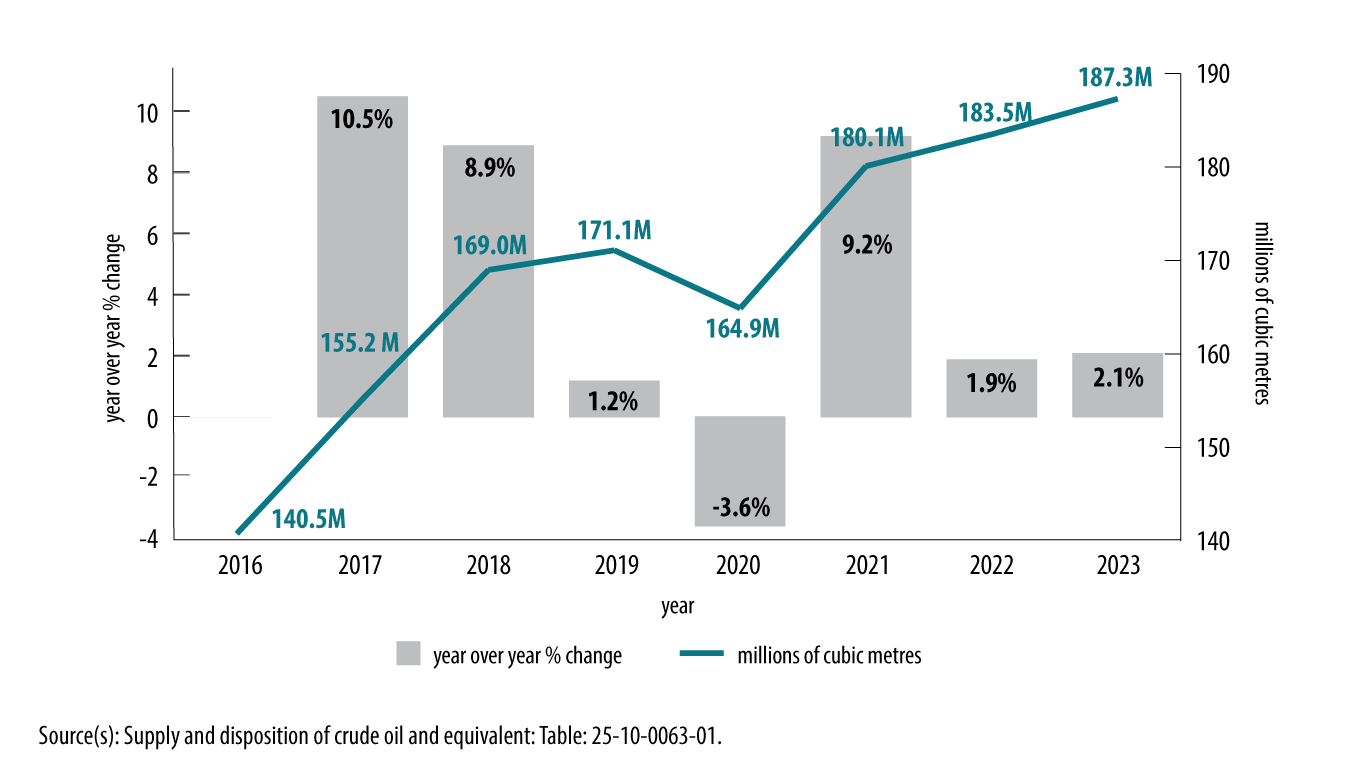
Geopolitical conflicts continued to cause uncertainty in the crude oil markets in 2023, although prices subsided from the elevated levels of 2022. Annual production of crude oil and equivalent products rose for the third consecutive year, up 1.4% to 286.4 million cubic metres in 2023, resulting in the highest volume since the start of this data series in 2016. Based on the latest available international data (2022), Canada remained among the top four oil producers worldwide.
The overall increase in 2023 was largely driven by production from the oil sands (+2.1%). In the second quarter, planned turnarounds in the oil sands coincided with wildfires across swathes of Western Canada, although the fires’ impact on crude oil production was minimal. Record monthly volumes of synthetic crude were produced in the second half of the year, following planned maintenance at synthetic crude oil upgraders that resulted in efficiency gains. Coinciding with some of these turnarounds in the third quarter, Canadian prices for crude oil and bitumen peaked in September 2023.
Chart 1: Oil sands extraction

Description - Chart 1: Oils sands extraction
Chart title: Oil sands extraction
This is a bar and line chart.
The vertical axis for the bar shows year over year change from -4% to +10%.
The vertical axis for the line shows 140 million cubic metres to 190 million cubic metres.
The horizontal axis shows the years 2016 to 2023.
The bar chart year-over-year change for 2017 is +10.5%, for 2018 is +8.9%, for 2019 is +1.2%, for 2020 is -3.6%, for 2021 is +9.2%, for 2022 is +1.9% and for 2023 is +2.1%.
The line chart volume in cubic metres for 2016 is 140.5 million, for 2017 is 155.2 million, for 2018 is 169.0 million, for 2019 is 171.1 million, for 2020 is 164.9 million, for 2021 is 180.1 million, for 2022 is 183.5 million and for 2023 is 187.3 million.
Source(s): Supply and disposition of crude oil and equivalent: Table: 25-10-0063-01.
Crude oil producers ramped up output at the end of the year in preparation for the upcoming completion of the Trans Mountain pipeline expansion, which will increase export capacity in 2024. Synthetic crude oil (+4.6% to 70.9 million cubic metres) was the main contributor to the overall growth of annual Canadian crude oil production in 2023.
Meanwhile, production of crude bitumen, which is also a feedstock for synthetic crude, was up 0.6% year over year to 116.5 million cubic metres in 2023. In-situ production, which has a smaller footprint and allows access to deeper bitumen deposits, continued to be the primary method of crude bitumen extraction. Overall, oil sands extraction represented a 65.4% share of total crude oil and equivalent products in 2023, up from 62.4% at the start of the series in 2016.
Oil extraction (except oil sands) has yet to return to the peak observed in 2019. In 2023, 71.1 million cubic metres were produced, down 0.5% from the previous year. Light and medium crude oil (-1.5%) made up the majority share of total oil extraction (except oil sands). However, production of higher density heavy oil has been moving in the opposite direction, reaching a series high of 25.3 million cubic metres in 2023. Although more costly to process, heavier crude oil remained the preferred input for many large refineries in the southern United States.
Canadian exports of crude oil and equivalent products also reached a record high in 2023. Steadily rising since 2021, crude oil exports totalled 230.0 million cubic metres, up 3.2% from 2022. As more Canadian crude oil was exported, stocks diminished throughout 2023. September marked the lowest monthly level of inventories since October 2019, prior to the buildup during the COVID-19 pandemic.
To learn more about crude oil data, check out the Canadian Centre for Energy Information’s Crude Oil dashboard. To follow crude oil data throughout the year, keep an eye on the monthly Energy Statistics release.
Other energy 2023 year-in-review articles include:
- Published March 5, 2024 - Hydroelectricity dries up amid record temperatures: Electricity year in review 2023
- Published March 12, 2024 - Canadian petroleum product refining returns to pre-pandemic levels: Refined petroleum products year in review 2023
- Published March 14, 2024 - Record natural gas production driven by industrial deliveries – Natural gas year in review 2023.

StatsCAN app
Did you know you can read StatsCAN Plus articles and more on the StatsCAN app? If you’re already using the app, let us know what you think by leaving a review in the App Store and Google Play.
Contact information
For more information, contact the Statistical Information Service (toll-free 1-800-263-1136; 514-283-8300; infostats@statcan.gc.ca) or Media Relations (statcan.mediahotline-ligneinfomedias.statcan@statcan.gc.ca).
